Introduction
Navigating the postpartum journey can be as challenging as it is rewarding, especially when it comes to understanding the changes in one’s body. The postpartum belly pouch, often surrounded by myths and misconceptions, is a common experience for many new mothers, yet it’s crucial to recognize that recovery is a unique journey for each individual.
Factors such as genetics, lifestyle, and even the physical demands of motherhood play significant roles in shaping the postpartum experience. By shifting the narrative from quick fixes to embracing holistic health strategies, mothers can foster a positive self-image and a supportive community.
This article delves into the realities of the postpartum belly pouch, exploring its causes, effective management strategies, and the importance of lifestyle changes, ultimately empowering women to celebrate their bodies and prioritize their well-being during this transformative phase.
Understanding the Postpartum Belly Pouch: Myths and Facts
The belly pouch that occurs postpartum is often enveloped in a cloud of myths that can add to the emotional burden of new mothers. A prevalent misconception is that all women will swiftly return to their pre-pregnancy shape. However, the reality is far more complex.
Various factors, such as genetics and lifestyle choices, significantly influence body changes after childbirth. In fact, the first three months after giving birth is a critical time for the restoration of muscle tone and connective tissue to the pre-pregnant state. It’s vital to recognize that each individual's journey is unique—what is normal for one may not be for another.
As Mandy Major, a certified doula, states, "And even then they still may look different, but damn if they aren’t absolutely incredible." Acknowledging that having a belly pouch is completely normal can help soothe emotional distress and foster a healthier mindset. By shifting the focus from appearance to overall health, mothers can cultivate a sense of empowerment during their recovery.
This approach not only promotes a positive self-image but also encourages a supportive environment where individuals can celebrate their bodies, appreciating them for the incredible transformations they have undergone. The study group characteristics further illustrate that the experiences of body transformations after childbirth are diverse, encompassing a range of ages, socio-economic statuses, and personal circumstances, reinforcing the notion that each woman's journey is indeed unique.
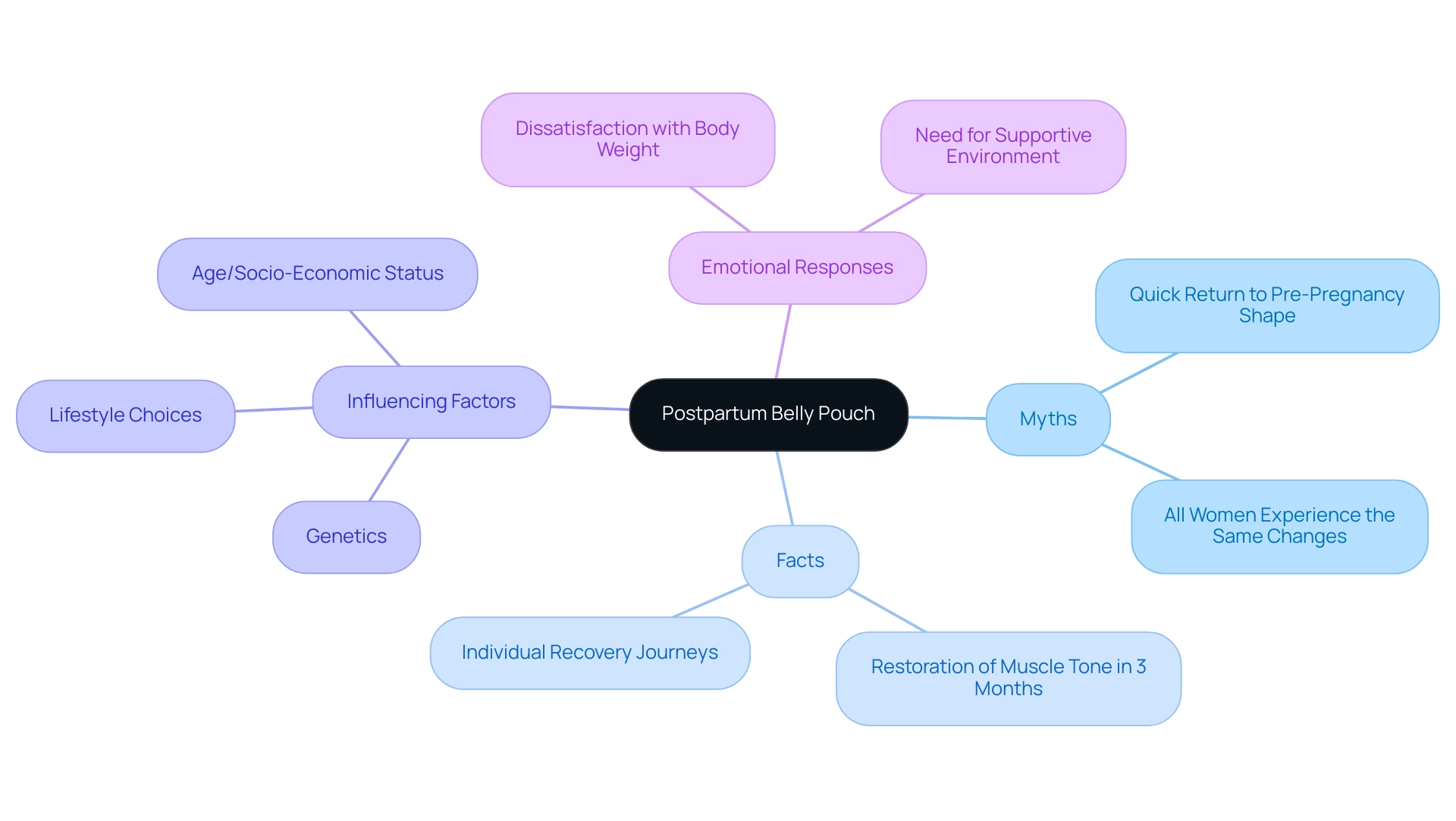
What Causes the Belly Pouch? Exploring Underlying Factors
The journey to understanding the development of a belly pouch after childbirth involves recognizing several critical factors, with the belly pouch's connection to diastasis recti (DRA) being a prominent concern. Research indicates a staggering prevalence of 74% in certain aged populations, underscoring the need for awareness and proactive measures. DRA occurs when the abdominal muscles separate during pregnancy, leading to a belly pouch that can affect physical and emotional well-being.
Moreover, hormonal variations significantly influence fat distribution and retention, further complicating body shape after childbirth. Factors such as increased body mass index (BMI), parity, and even diabetes have been identified as plausible risk factors in studies, with a multivariate analysis showing that only higher age, increased BMI, and parity remained significantly correlated with DRA. Additionally, a case study titled "Conclusions on DRA Prevalence and Risk Factors" highlights the uncertainty surrounding the actual prevalence of DRA due to varying measurement methods and criteria.
This study calls for larger sample size investigations to better understand DRA and its risk factors, aiming to improve surgical techniques and patient identification. By recognizing these interconnected causes, individuals can better customize their efforts to address postpartum body transformations effectively. This understanding not only empowers personal health journeys but also enhances the support HR Benefits Managers can provide to their teams, fostering an environment that prioritizes well-being and recovery.
As noted by Suzhen Qian, the analysis and critical revision of the manuscript for intellectual content is crucial in advancing our understanding of these issues.
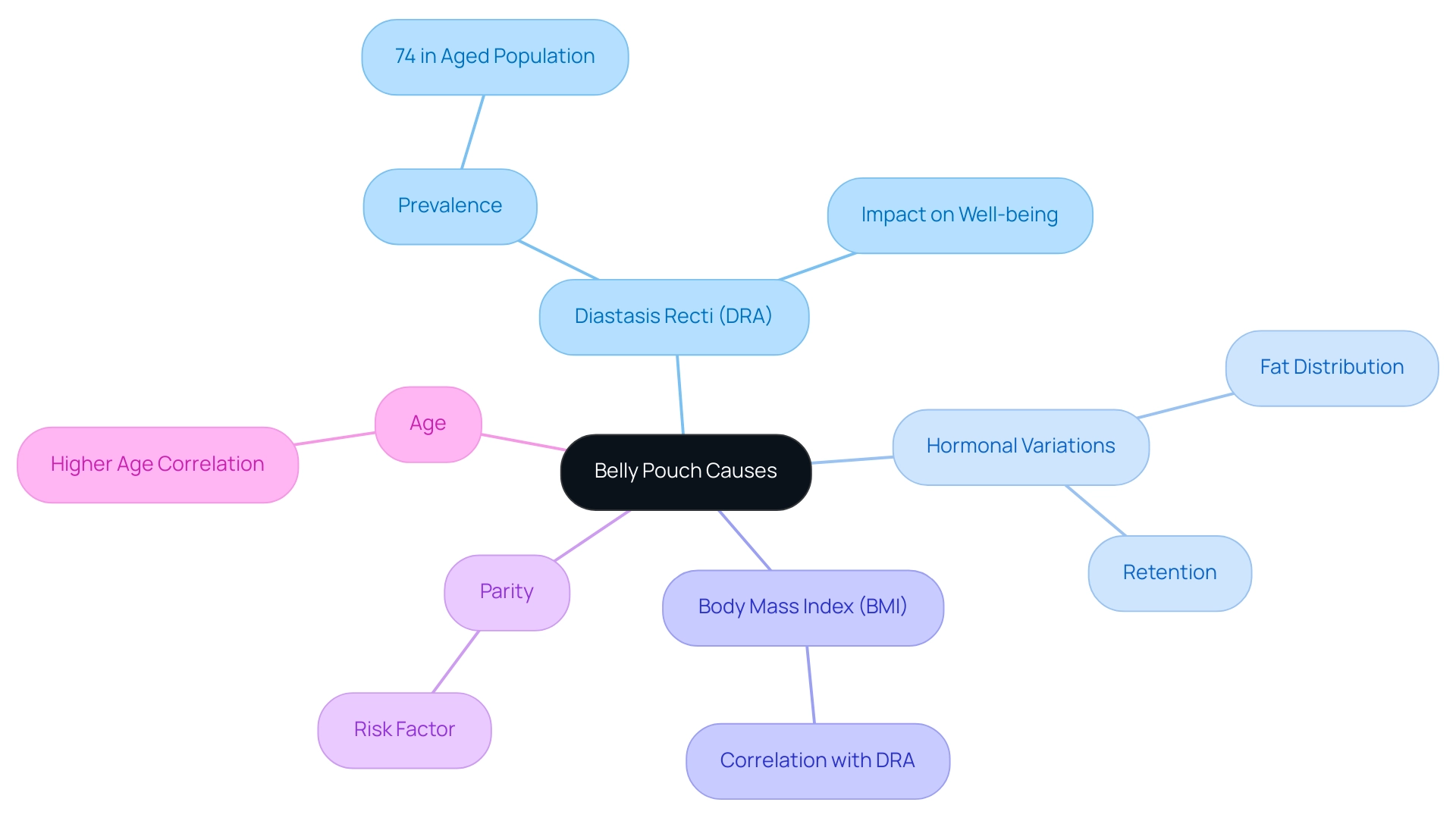
Effective Strategies for Reducing Your Belly Pouch
To effectively reduce your belly pouch, it's essential to adopt a holistic approach that includes:
- Exercise
- Dietary adjustments
- Mindfulness practices
Engaging in core-strengthening exercises such as Pilates and yoga plays a crucial role in supporting and stabilizing your abdominal muscles. Our comprehensive health coaching services at Foresight Health Coaching offer personalized fitness coaching and nutrition guidance through our user-friendly app, ensuring you have the resources you need to succeed.
The app features:
- Daily programming to keep you on track
- Video demonstrations for visual learners
- Movement flows to help maintain your physical activity
Adjusted analyses indicate a significantly higher prevalence of abdominal pain in women with diastasis recti (DRA) with an odds ratio of 0.02 (95% CI: 0.00 to 0.61; p = 0.026), underscoring the importance of addressing these abdominal issues. Ayse Kavasoglu Kaya notes that 'physiotherapy interventions as core stabilization exercises and the abdominal corset can positively impact IRD, trunk flexion muscle strength and endurance, balance and disability in DRA management.'
Complementing your workout routine with a diet abundant in whole foods, lean proteins, and healthy fats will further enhance your results. Staying hydrated is key, too. Additionally, our corporate memberships offer tailored wellness programs that include:
- In-person wellness talks
- Nutrition services
- Access to our app for up to 30 employees
This makes it easier for organizations to foster a healthy workplace.
Incorporating mindfulness and stress management techniques—including meditation and deep breathing—can significantly mitigate stress-related weight gain, which is vital in today’s fast-paced environment. Remember, small, consistent changes can lead to transformative results over time, fostering a healthier lifestyle for you and inspiring those around you.
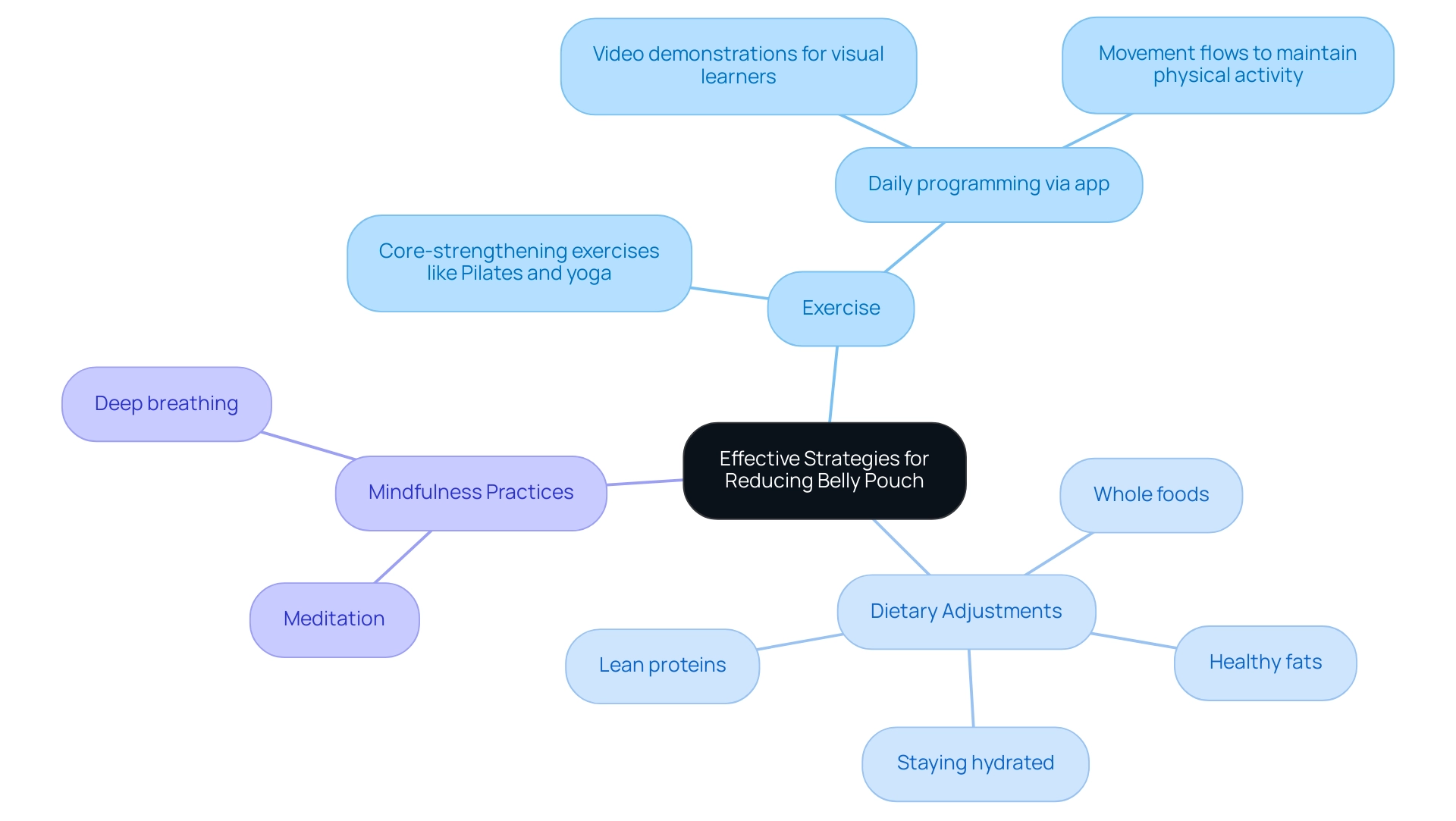
The Importance of Lifestyle Changes in Managing Belly Pouch
Adopting a healthier lifestyle is crucial for effectively managing your belly pouch following childbirth. Regular physical activity, adherence to a balanced diet, and prioritizing quality sleep are critical components of this journey. Current guidelines recommend aiming for at least 150 minutes of moderate aerobic activity each week, along with strength training exercises on two or more days.
The Essential Coaching Plan, priced at just $67/month, offers affordable, curated workout programs tailored specifically to these needs, helping you achieve your fitness goals while fitting into your busy schedule. You can select from goal-oriented choices such as:
- Muscle Gain
- Weight Loss
- Endurance
- Overall Fitness
This ensures that the program aligns with your personal objectives. Additionally, experience level options are available, catering to:
- Beginners
- Intermediate
- Advanced users
This allows for a structured approach to your fitness journey.
As stated by the Committee on Obstetric Practice, 'In the absence of obstetric or medical complications or contraindications, physical activity in pregnancy is safe and desirable, and pregnant women should be encouraged to continue or to initiate safe physical activities.' Meal prepping serves as an invaluable tool to help you remain committed to nutritious eating, significantly reducing the temptation to opt for less healthy choices. Additionally, ensuring adequate sleep and practicing self-care are vital, as both stress and fatigue can impede your progress.
Data analysis from the Pregnancy, Infection and Nutrition Study after childbirth highlights the relationship between fatigue and physical activity, emphasizing the need for lifestyle adjustments after delivery. By adopting these lifestyle adjustments, along with the guidance of the Essential Coaching Plan, you are not only targeting a specific area but also enhancing your overall well-being, ultimately fostering a healthier and more vibrant life. Moreover, understanding the anatomic and physiologic alterations that occur during pregnancy can help customize exercise recommendations, ensuring that postpartum women can safely and effectively manage their health.
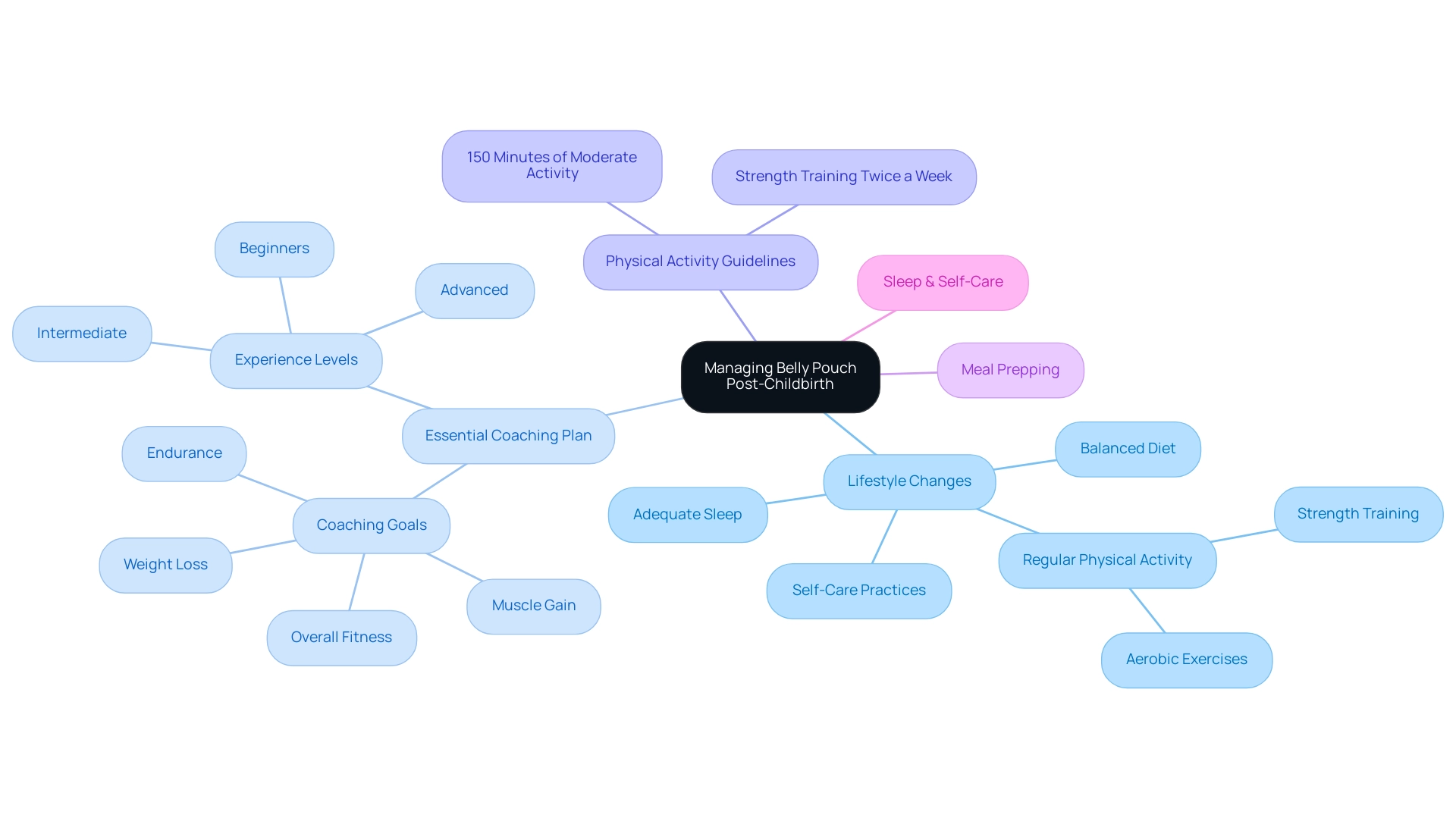
Surgical Options for Addressing the Belly Pouch
For those eager to achieve swift and noticeable results, surgical options like abdominoplasty (commonly known as a tummy tuck) or liposuction are viable pathways to reduce excess fat around the belly pouch. In fact, statistics reveal that sixty-five percent of patients undergo abdominoplasty combined with other cosmetic surgery procedures, underscoring the popularity of these options. However, the journey toward the best outcome begins with a consultation with a qualified healthcare provider who can offer personalized recommendations tailored to individual health needs and aspirations.
As Michael J. Stein, MD, notes,
Taking advantage of quality-improvement data submitted by US Board-certified plastic surgeons, our study provides new insight on the evolution of the abdominoplasty technique.
This highlights the importance of being well-informed before proceeding. Additionally, a recent case study concluded that liposuction and abdominoplasty can be performed safely with measures to reduce complications, emphasizing scalpel dissection and deep fascial repair.
It's essential to recognize that surgery is not a solitary solution; its effectiveness is greatly enhanced when integrated with ongoing lifestyle changes. By understanding the full spectrum of available options, individuals can confidently navigate their path to achieving their health and wellness goals, ensuring that their choices resonate with their values and aspirations.
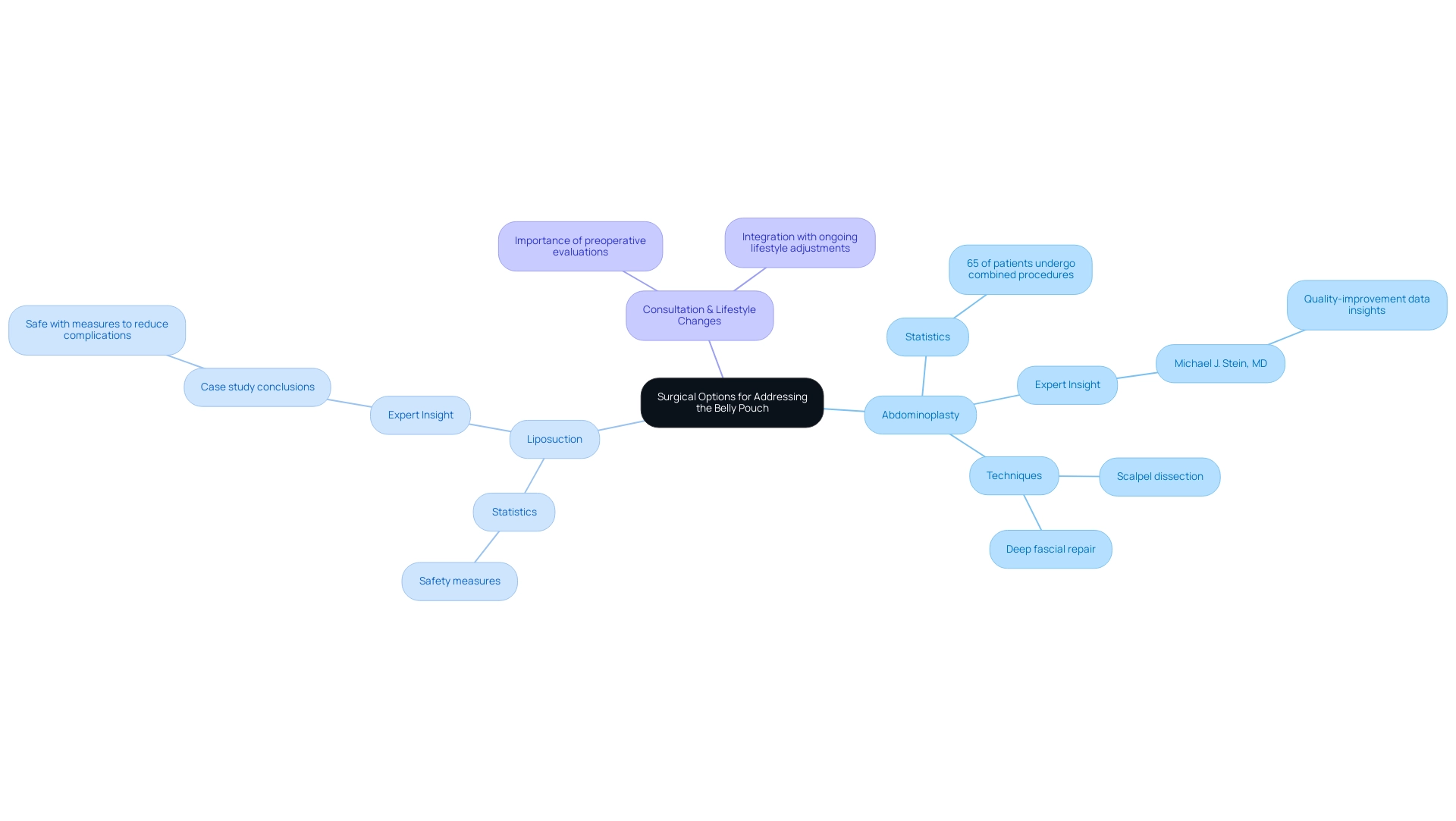
Conclusion
Embracing the journey of postpartum recovery involves understanding the realities of the belly pouch and recognizing the unique experiences of each mother. The myths surrounding quick fixes can often overshadow the importance of acknowledging the complex factors at play, such as genetics, hormonal changes, and the physical demands of motherhood. By shifting the focus from appearance to health, mothers can cultivate empowerment and foster a positive self-image, allowing them to appreciate the incredible transformations their bodies have undergone.
Effective management strategies, including:
- Exercise
- Dietary adjustments
- Mindfulness practices
play a crucial role in addressing the postpartum belly pouch. Engaging in core-strengthening activities, maintaining a balanced diet, and prioritizing self-care can lead to significant improvements over time. It is essential to remember that small, consistent changes can foster a healthier lifestyle, encouraging not only personal well-being but also inspiring those around.
For those considering surgical options, it is vital to approach these decisions with a clear understanding of the available pathways and their integration with ongoing lifestyle changes. The journey towards recovery and body acceptance is multifaceted, and by prioritizing holistic health strategies, mothers can celebrate their bodies and enhance their overall well-being. Now is the time to embrace this transformative phase with confidence and support, paving the way for a healthier future.
Frequently Asked Questions
What is a common misconception about postpartum body changes?
A prevalent misconception is that all women will quickly return to their pre-pregnancy shape after childbirth, but the reality is more complex and varies for each individual.
What factors influence body changes after childbirth?
Various factors such as genetics, lifestyle choices, hormonal variations, body mass index (BMI), parity, and age significantly influence body changes postpartum.
Why is the first three months after giving birth considered critical?
The first three months are crucial for the restoration of muscle tone and connective tissue to the pre-pregnant state, making it an important time for recovery.
What is diastasis recti (DRA) and how does it relate to postpartum body changes?
Diastasis recti (DRA) is a condition where the abdominal muscles separate during pregnancy, leading to a belly pouch. It affects a significant percentage of women postpartum and can impact both physical and emotional well-being.
What are some identified risk factors for DRA?
Risk factors for DRA include increased BMI, parity (number of pregnancies), and age. Studies suggest that these factors are significantly correlated with the prevalence of DRA.
How can acknowledging the presence of a belly pouch benefit new mothers?
Recognizing that having a belly pouch is normal can help alleviate emotional distress and promote a healthier mindset, allowing mothers to focus on overall health rather than appearance.
How do hormonal variations affect postpartum body shape?
Hormonal changes can influence fat distribution and retention, complicating body shape after childbirth.
What role do supportive environments play in postpartum recovery?
A supportive environment encourages mothers to celebrate their bodies and appreciate the transformations they have undergone, fostering a positive self-image and empowerment during recovery.

